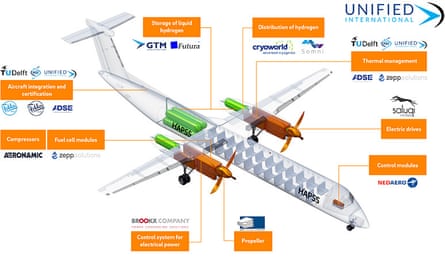The world’s first hydrogen-fuelled commercial flight of a passenger plane could take place between Rotterdam and London in six years’ time, under a plan to make short-haul air travel more environmentally friendly.
The 2028 target set by a Dutch consortium is ambitious. Airbus announced its intention 18 months ago to be the first to offer zero-emission commercial aircraft models running on hydrogen, by 2035.
Burning hydrogen produces no carbon greenhouse gas emissions, making it a clean fuel option for heavy vehicles such as planes, trains and trucks. However, the process of creating hydrogen is only clean if the energy used is renewable, and, depending on the method of burning, it can cause health-harming air pollution.
The Dutch technology will initially be built into an existing turboprop aircraft with 40-80 seats, and it could then be used in adapted larger aircraft.
Michel van Ierland, of the consortium set up by Unified International and the Dutch regional economic development agency InnovationQuarter, whose partners include the Dutch aircraft manufacturer Fokker and Delft University of Technology, said the scheme would open up a €16bn market for the Netherlands.
“This is very interesting for Scandinavia and New Zealand, for example, where for shorter distances people are still focusing on battery-electric technology,” he said, referring to plans for battery-powered commercial planes.
The use of hydrogen for fuel requires a redesign of planes, as liquid hydrogen needs to be stored in relatively heavy, insulated tanks. While conventional fuel is usually stored in the wings, the Dutch plan is to have hydrogen capsules in the plane’s tail.

The planes could be a little slower over medium-haul journeys, but the duration of a short trip – such as between the Netherlands and the UK – would be little changed. Tests suggest a hydrogen-powered propeller plane should be capable of speeds of up to 370mph (600km/h), compared with 530mph for a Boeing 747 jumbo jet.
The aviation industry is responsible for about 2.4% of annual global carbon emissions. Surveys suggest nine out of 10 short-haul passengers would be willing to pay more if they could be assured that their travel is emission-free.
In 2008 Boeing flew the world’s first hydrogen-powered plane, a single-seater vehicle, from an airfield near Madrid, Spain.
